Law for Business Managers
VerifiedAdded on 2023/01/06
|12
|3594
|88
AI Summary
This document provides a comprehensive guide for business managers on contract law, tort law of negligence, and business law. It explains the meaning of representation and how it differs from a term of a contract. It also discusses the elements of a successful claim for negligence and the features of an artificial person. The document covers the legal framework for business organizations and provides insights for business managers.
Contribute Materials
Your contribution can guide someone’s learning journey. Share your
documents today.
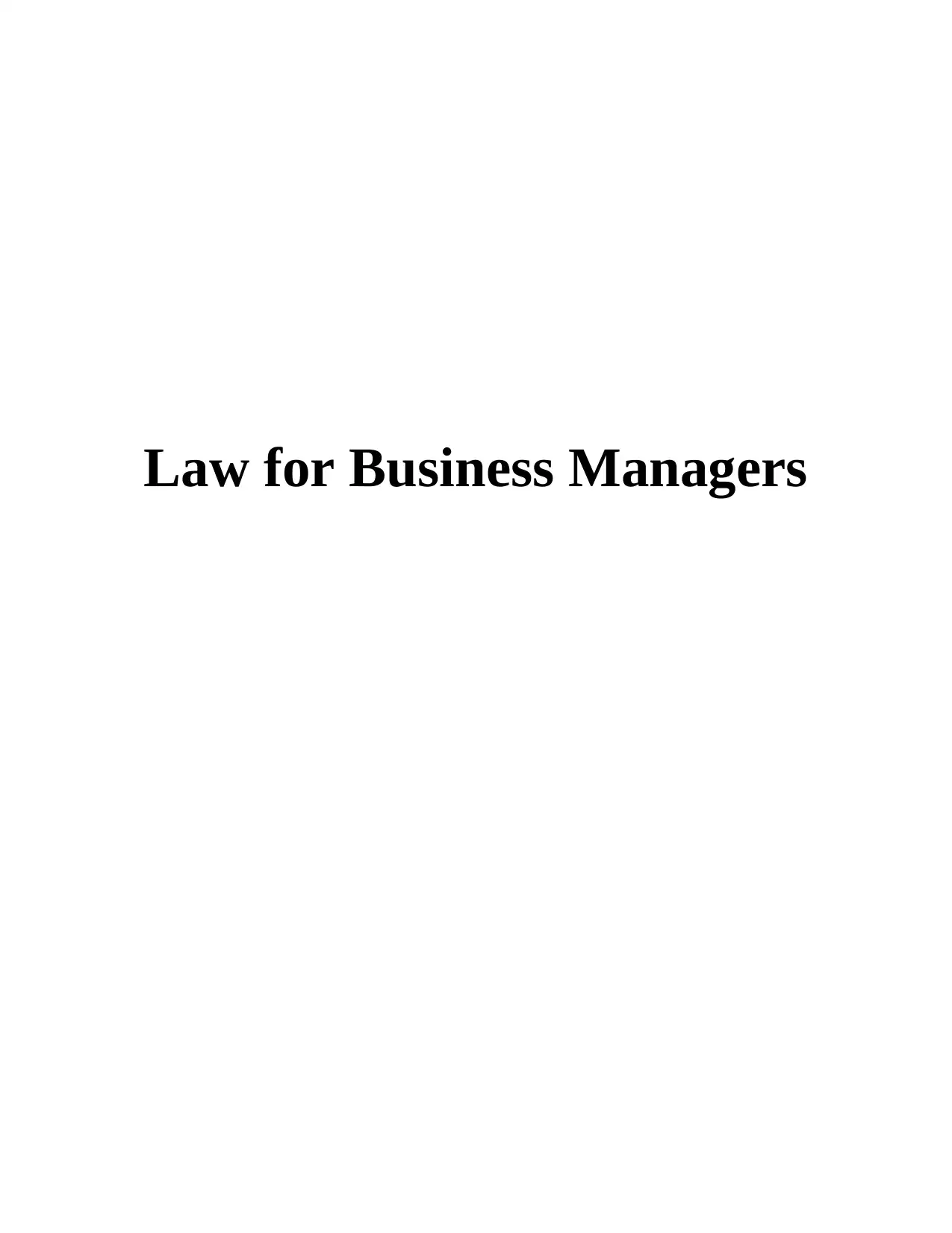
Law for Business Managers
Secure Best Marks with AI Grader
Need help grading? Try our AI Grader for instant feedback on your assignments.
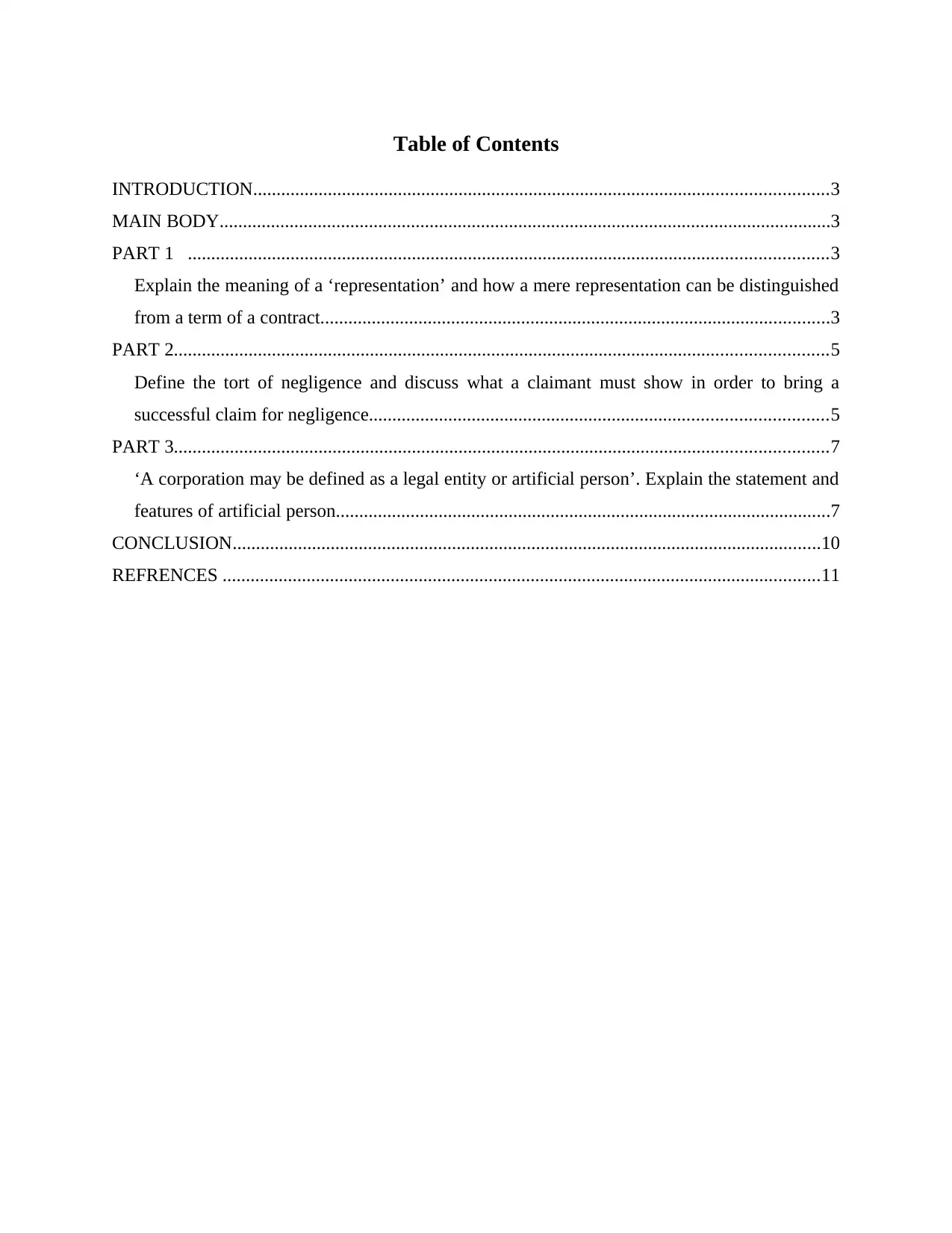
Table of Contents
INTRODUCTION...........................................................................................................................3
MAIN BODY...................................................................................................................................3
PART 1 .........................................................................................................................................3
Explain the meaning of a ‘representation’ and how a mere representation can be distinguished
from a term of a contract.............................................................................................................3
PART 2............................................................................................................................................5
Define the tort of negligence and discuss what a claimant must show in order to bring a
successful claim for negligence..................................................................................................5
PART 3............................................................................................................................................7
‘A corporation may be defined as a legal entity or artificial person’. Explain the statement and
features of artificial person..........................................................................................................7
CONCLUSION..............................................................................................................................10
REFRENCES ................................................................................................................................11
INTRODUCTION...........................................................................................................................3
MAIN BODY...................................................................................................................................3
PART 1 .........................................................................................................................................3
Explain the meaning of a ‘representation’ and how a mere representation can be distinguished
from a term of a contract.............................................................................................................3
PART 2............................................................................................................................................5
Define the tort of negligence and discuss what a claimant must show in order to bring a
successful claim for negligence..................................................................................................5
PART 3............................................................................................................................................7
‘A corporation may be defined as a legal entity or artificial person’. Explain the statement and
features of artificial person..........................................................................................................7
CONCLUSION..............................................................................................................................10
REFRENCES ................................................................................................................................11
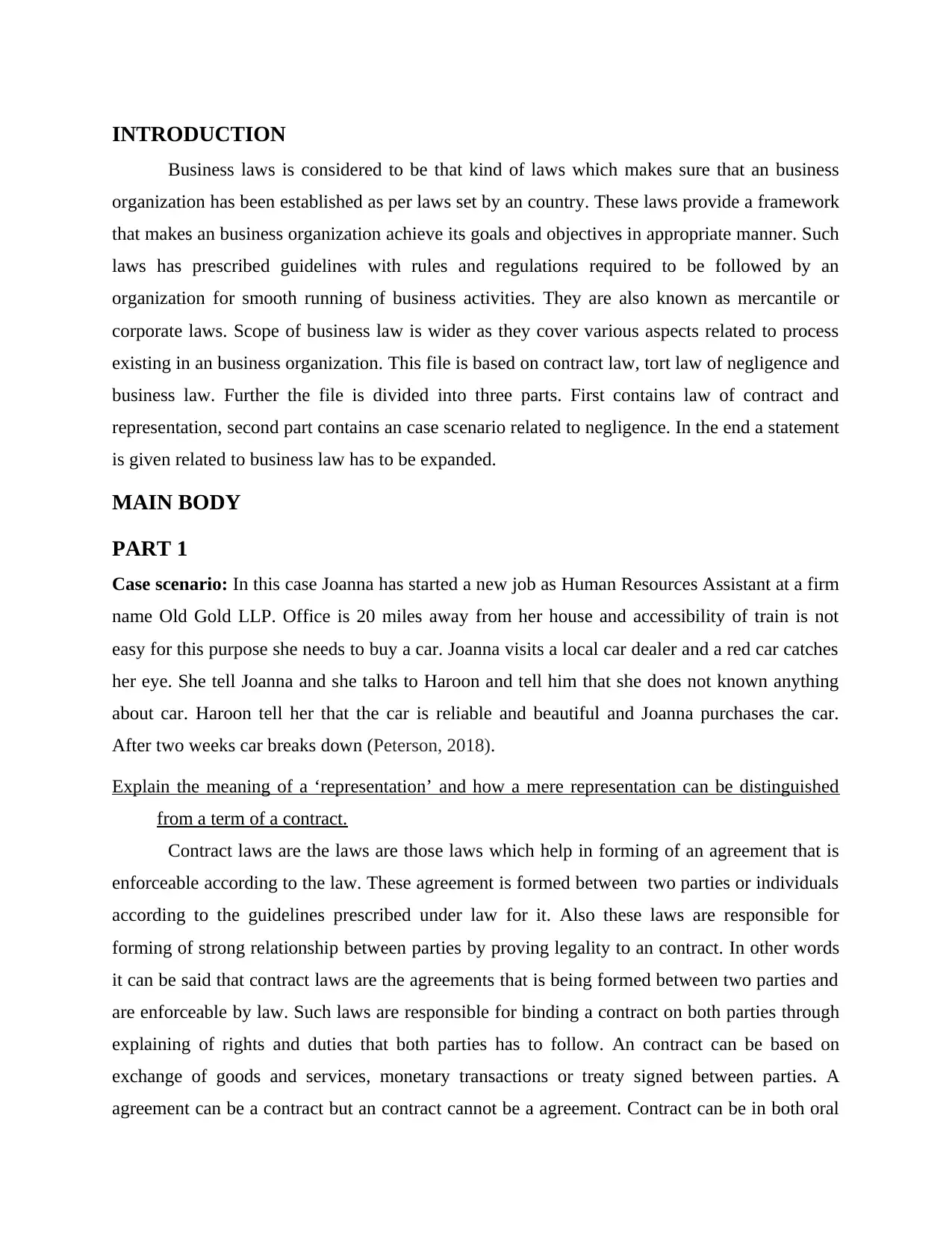
INTRODUCTION
Business laws is considered to be that kind of laws which makes sure that an business
organization has been established as per laws set by an country. These laws provide a framework
that makes an business organization achieve its goals and objectives in appropriate manner. Such
laws has prescribed guidelines with rules and regulations required to be followed by an
organization for smooth running of business activities. They are also known as mercantile or
corporate laws. Scope of business law is wider as they cover various aspects related to process
existing in an business organization. This file is based on contract law, tort law of negligence and
business law. Further the file is divided into three parts. First contains law of contract and
representation, second part contains an case scenario related to negligence. In the end a statement
is given related to business law has to be expanded.
MAIN BODY
PART 1
Case scenario: In this case Joanna has started a new job as Human Resources Assistant at a firm
name Old Gold LLP. Office is 20 miles away from her house and accessibility of train is not
easy for this purpose she needs to buy a car. Joanna visits a local car dealer and a red car catches
her eye. She tell Joanna and she talks to Haroon and tell him that she does not known anything
about car. Haroon tell her that the car is reliable and beautiful and Joanna purchases the car.
After two weeks car breaks down (Peterson, 2018).
Explain the meaning of a ‘representation’ and how a mere representation can be distinguished
from a term of a contract.
Contract laws are the laws are those laws which help in forming of an agreement that is
enforceable according to the law. These agreement is formed between two parties or individuals
according to the guidelines prescribed under law for it. Also these laws are responsible for
forming of strong relationship between parties by proving legality to an contract. In other words
it can be said that contract laws are the agreements that is being formed between two parties and
are enforceable by law. Such laws are responsible for binding a contract on both parties through
explaining of rights and duties that both parties has to follow. An contract can be based on
exchange of goods and services, monetary transactions or treaty signed between parties. A
agreement can be a contract but an contract cannot be a agreement. Contract can be in both oral
Business laws is considered to be that kind of laws which makes sure that an business
organization has been established as per laws set by an country. These laws provide a framework
that makes an business organization achieve its goals and objectives in appropriate manner. Such
laws has prescribed guidelines with rules and regulations required to be followed by an
organization for smooth running of business activities. They are also known as mercantile or
corporate laws. Scope of business law is wider as they cover various aspects related to process
existing in an business organization. This file is based on contract law, tort law of negligence and
business law. Further the file is divided into three parts. First contains law of contract and
representation, second part contains an case scenario related to negligence. In the end a statement
is given related to business law has to be expanded.
MAIN BODY
PART 1
Case scenario: In this case Joanna has started a new job as Human Resources Assistant at a firm
name Old Gold LLP. Office is 20 miles away from her house and accessibility of train is not
easy for this purpose she needs to buy a car. Joanna visits a local car dealer and a red car catches
her eye. She tell Joanna and she talks to Haroon and tell him that she does not known anything
about car. Haroon tell her that the car is reliable and beautiful and Joanna purchases the car.
After two weeks car breaks down (Peterson, 2018).
Explain the meaning of a ‘representation’ and how a mere representation can be distinguished
from a term of a contract.
Contract laws are the laws are those laws which help in forming of an agreement that is
enforceable according to the law. These agreement is formed between two parties or individuals
according to the guidelines prescribed under law for it. Also these laws are responsible for
forming of strong relationship between parties by proving legality to an contract. In other words
it can be said that contract laws are the agreements that is being formed between two parties and
are enforceable by law. Such laws are responsible for binding a contract on both parties through
explaining of rights and duties that both parties has to follow. An contract can be based on
exchange of goods and services, monetary transactions or treaty signed between parties. A
agreement can be a contract but an contract cannot be a agreement. Contract can be in both oral
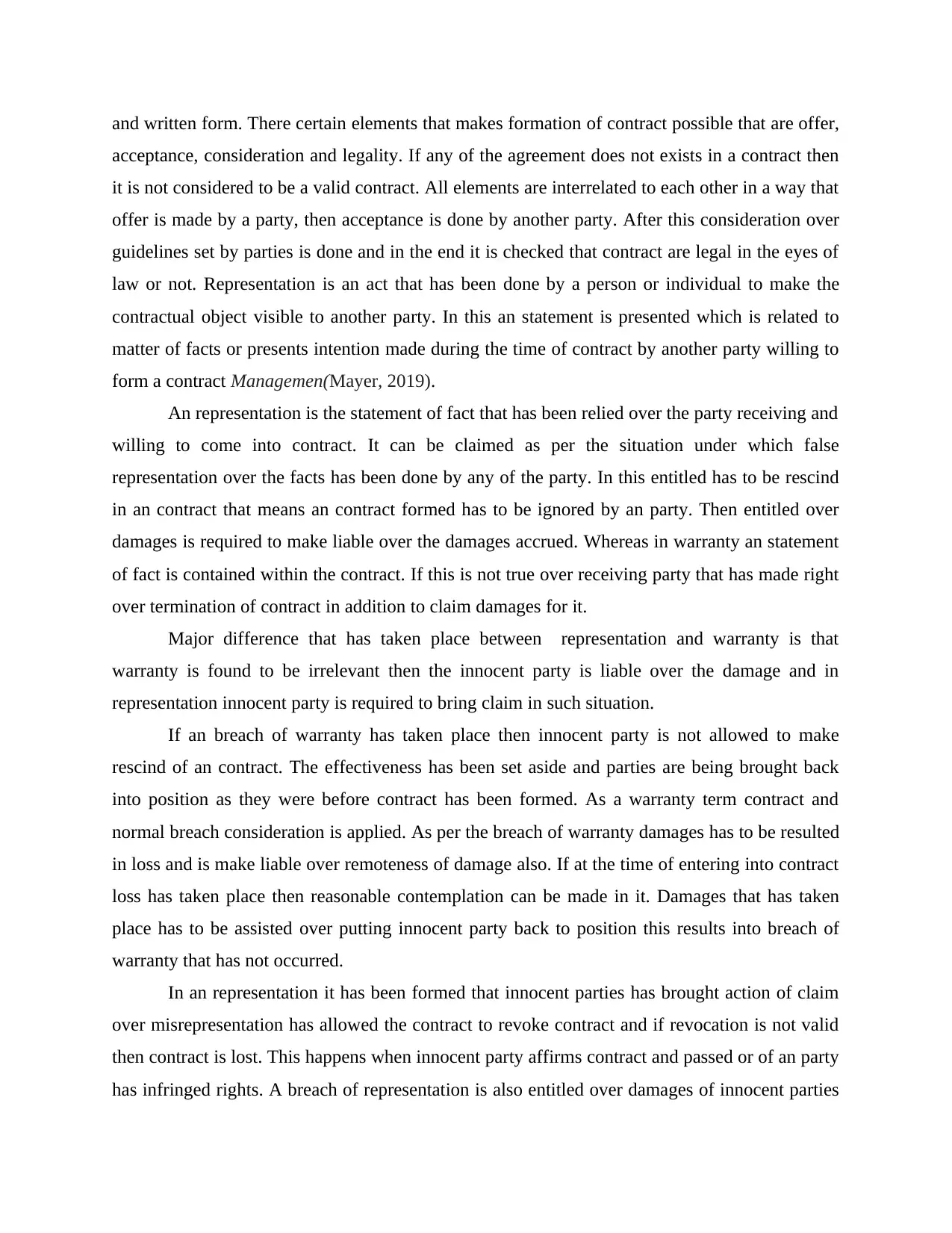
and written form. There certain elements that makes formation of contract possible that are offer,
acceptance, consideration and legality. If any of the agreement does not exists in a contract then
it is not considered to be a valid contract. All elements are interrelated to each other in a way that
offer is made by a party, then acceptance is done by another party. After this consideration over
guidelines set by parties is done and in the end it is checked that contract are legal in the eyes of
law or not. Representation is an act that has been done by a person or individual to make the
contractual object visible to another party. In this an statement is presented which is related to
matter of facts or presents intention made during the time of contract by another party willing to
form a contract Managemen(Mayer, 2019).
An representation is the statement of fact that has been relied over the party receiving and
willing to come into contract. It can be claimed as per the situation under which false
representation over the facts has been done by any of the party. In this entitled has to be rescind
in an contract that means an contract formed has to be ignored by an party. Then entitled over
damages is required to make liable over the damages accrued. Whereas in warranty an statement
of fact is contained within the contract. If this is not true over receiving party that has made right
over termination of contract in addition to claim damages for it.
Major difference that has taken place between representation and warranty is that
warranty is found to be irrelevant then the innocent party is liable over the damage and in
representation innocent party is required to bring claim in such situation.
If an breach of warranty has taken place then innocent party is not allowed to make
rescind of an contract. The effectiveness has been set aside and parties are being brought back
into position as they were before contract has been formed. As a warranty term contract and
normal breach consideration is applied. As per the breach of warranty damages has to be resulted
in loss and is make liable over remoteness of damage also. If at the time of entering into contract
loss has taken place then reasonable contemplation can be made in it. Damages that has taken
place has to be assisted over putting innocent party back to position this results into breach of
warranty that has not occurred.
In an representation it has been formed that innocent parties has brought action of claim
over misrepresentation has allowed the contract to revoke contract and if revocation is not valid
then contract is lost. This happens when innocent party affirms contract and passed or of an party
has infringed rights. A breach of representation is also entitled over damages of innocent parties
acceptance, consideration and legality. If any of the agreement does not exists in a contract then
it is not considered to be a valid contract. All elements are interrelated to each other in a way that
offer is made by a party, then acceptance is done by another party. After this consideration over
guidelines set by parties is done and in the end it is checked that contract are legal in the eyes of
law or not. Representation is an act that has been done by a person or individual to make the
contractual object visible to another party. In this an statement is presented which is related to
matter of facts or presents intention made during the time of contract by another party willing to
form a contract Managemen(Mayer, 2019).
An representation is the statement of fact that has been relied over the party receiving and
willing to come into contract. It can be claimed as per the situation under which false
representation over the facts has been done by any of the party. In this entitled has to be rescind
in an contract that means an contract formed has to be ignored by an party. Then entitled over
damages is required to make liable over the damages accrued. Whereas in warranty an statement
of fact is contained within the contract. If this is not true over receiving party that has made right
over termination of contract in addition to claim damages for it.
Major difference that has taken place between representation and warranty is that
warranty is found to be irrelevant then the innocent party is liable over the damage and in
representation innocent party is required to bring claim in such situation.
If an breach of warranty has taken place then innocent party is not allowed to make
rescind of an contract. The effectiveness has been set aside and parties are being brought back
into position as they were before contract has been formed. As a warranty term contract and
normal breach consideration is applied. As per the breach of warranty damages has to be resulted
in loss and is make liable over remoteness of damage also. If at the time of entering into contract
loss has taken place then reasonable contemplation can be made in it. Damages that has taken
place has to be assisted over putting innocent party back to position this results into breach of
warranty that has not occurred.
In an representation it has been formed that innocent parties has brought action of claim
over misrepresentation has allowed the contract to revoke contract and if revocation is not valid
then contract is lost. This happens when innocent party affirms contract and passed or of an party
has infringed rights. A breach of representation is also entitled over damages of innocent parties
Secure Best Marks with AI Grader
Need help grading? Try our AI Grader for instant feedback on your assignments.
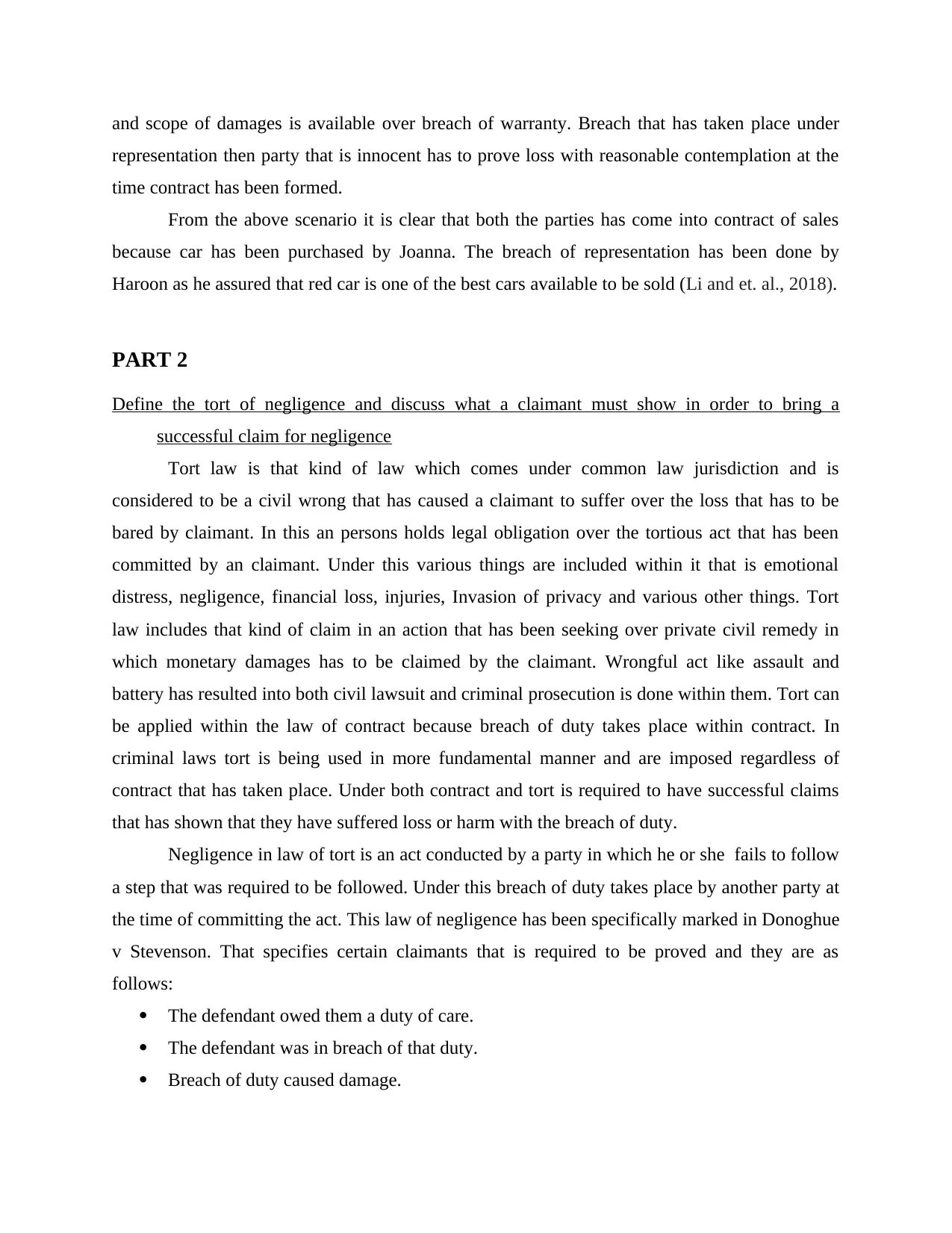
and scope of damages is available over breach of warranty. Breach that has taken place under
representation then party that is innocent has to prove loss with reasonable contemplation at the
time contract has been formed.
From the above scenario it is clear that both the parties has come into contract of sales
because car has been purchased by Joanna. The breach of representation has been done by
Haroon as he assured that red car is one of the best cars available to be sold (Li and et. al., 2018).
PART 2
Define the tort of negligence and discuss what a claimant must show in order to bring a
successful claim for negligence
Tort law is that kind of law which comes under common law jurisdiction and is
considered to be a civil wrong that has caused a claimant to suffer over the loss that has to be
bared by claimant. In this an persons holds legal obligation over the tortious act that has been
committed by an claimant. Under this various things are included within it that is emotional
distress, negligence, financial loss, injuries, Invasion of privacy and various other things. Tort
law includes that kind of claim in an action that has been seeking over private civil remedy in
which monetary damages has to be claimed by the claimant. Wrongful act like assault and
battery has resulted into both civil lawsuit and criminal prosecution is done within them. Tort can
be applied within the law of contract because breach of duty takes place within contract. In
criminal laws tort is being used in more fundamental manner and are imposed regardless of
contract that has taken place. Under both contract and tort is required to have successful claims
that has shown that they have suffered loss or harm with the breach of duty.
Negligence in law of tort is an act conducted by a party in which he or she fails to follow
a step that was required to be followed. Under this breach of duty takes place by another party at
the time of committing the act. This law of negligence has been specifically marked in Donoghue
v Stevenson. That specifies certain claimants that is required to be proved and they are as
follows:
The defendant owed them a duty of care.
The defendant was in breach of that duty.
Breach of duty caused damage.
representation then party that is innocent has to prove loss with reasonable contemplation at the
time contract has been formed.
From the above scenario it is clear that both the parties has come into contract of sales
because car has been purchased by Joanna. The breach of representation has been done by
Haroon as he assured that red car is one of the best cars available to be sold (Li and et. al., 2018).
PART 2
Define the tort of negligence and discuss what a claimant must show in order to bring a
successful claim for negligence
Tort law is that kind of law which comes under common law jurisdiction and is
considered to be a civil wrong that has caused a claimant to suffer over the loss that has to be
bared by claimant. In this an persons holds legal obligation over the tortious act that has been
committed by an claimant. Under this various things are included within it that is emotional
distress, negligence, financial loss, injuries, Invasion of privacy and various other things. Tort
law includes that kind of claim in an action that has been seeking over private civil remedy in
which monetary damages has to be claimed by the claimant. Wrongful act like assault and
battery has resulted into both civil lawsuit and criminal prosecution is done within them. Tort can
be applied within the law of contract because breach of duty takes place within contract. In
criminal laws tort is being used in more fundamental manner and are imposed regardless of
contract that has taken place. Under both contract and tort is required to have successful claims
that has shown that they have suffered loss or harm with the breach of duty.
Negligence in law of tort is an act conducted by a party in which he or she fails to follow
a step that was required to be followed. Under this breach of duty takes place by another party at
the time of committing the act. This law of negligence has been specifically marked in Donoghue
v Stevenson. That specifies certain claimants that is required to be proved and they are as
follows:
The defendant owed them a duty of care.
The defendant was in breach of that duty.
Breach of duty caused damage.
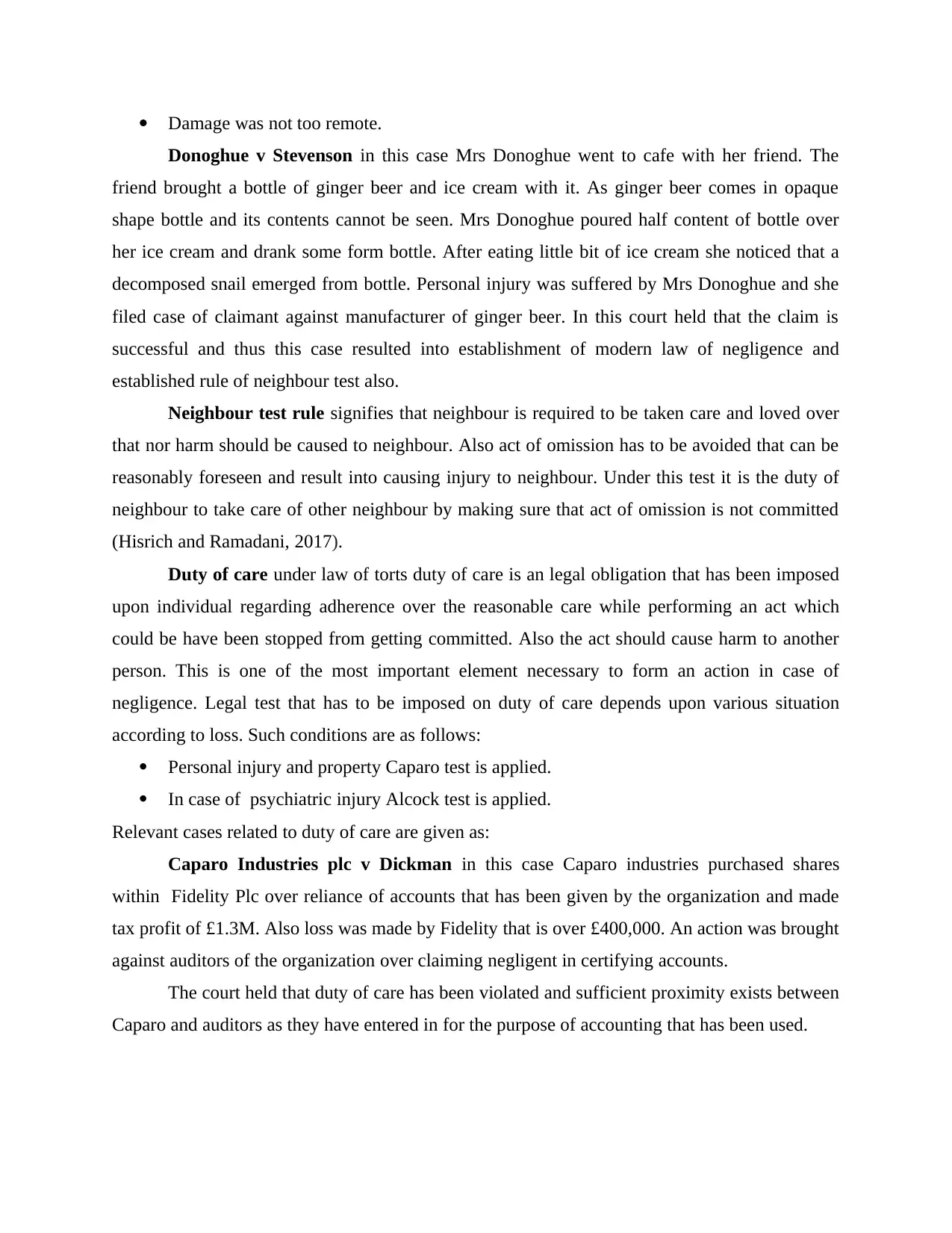
Damage was not too remote.
Donoghue v Stevenson in this case Mrs Donoghue went to cafe with her friend. The
friend brought a bottle of ginger beer and ice cream with it. As ginger beer comes in opaque
shape bottle and its contents cannot be seen. Mrs Donoghue poured half content of bottle over
her ice cream and drank some form bottle. After eating little bit of ice cream she noticed that a
decomposed snail emerged from bottle. Personal injury was suffered by Mrs Donoghue and she
filed case of claimant against manufacturer of ginger beer. In this court held that the claim is
successful and thus this case resulted into establishment of modern law of negligence and
established rule of neighbour test also.
Neighbour test rule signifies that neighbour is required to be taken care and loved over
that nor harm should be caused to neighbour. Also act of omission has to be avoided that can be
reasonably foreseen and result into causing injury to neighbour. Under this test it is the duty of
neighbour to take care of other neighbour by making sure that act of omission is not committed
(Hisrich and Ramadani, 2017).
Duty of care under law of torts duty of care is an legal obligation that has been imposed
upon individual regarding adherence over the reasonable care while performing an act which
could be have been stopped from getting committed. Also the act should cause harm to another
person. This is one of the most important element necessary to form an action in case of
negligence. Legal test that has to be imposed on duty of care depends upon various situation
according to loss. Such conditions are as follows:
Personal injury and property Caparo test is applied.
In case of psychiatric injury Alcock test is applied.
Relevant cases related to duty of care are given as:
Caparo Industries plc v Dickman in this case Caparo industries purchased shares
within Fidelity Plc over reliance of accounts that has been given by the organization and made
tax profit of £1.3M. Also loss was made by Fidelity that is over £400,000. An action was brought
against auditors of the organization over claiming negligent in certifying accounts.
The court held that duty of care has been violated and sufficient proximity exists between
Caparo and auditors as they have entered in for the purpose of accounting that has been used.
Donoghue v Stevenson in this case Mrs Donoghue went to cafe with her friend. The
friend brought a bottle of ginger beer and ice cream with it. As ginger beer comes in opaque
shape bottle and its contents cannot be seen. Mrs Donoghue poured half content of bottle over
her ice cream and drank some form bottle. After eating little bit of ice cream she noticed that a
decomposed snail emerged from bottle. Personal injury was suffered by Mrs Donoghue and she
filed case of claimant against manufacturer of ginger beer. In this court held that the claim is
successful and thus this case resulted into establishment of modern law of negligence and
established rule of neighbour test also.
Neighbour test rule signifies that neighbour is required to be taken care and loved over
that nor harm should be caused to neighbour. Also act of omission has to be avoided that can be
reasonably foreseen and result into causing injury to neighbour. Under this test it is the duty of
neighbour to take care of other neighbour by making sure that act of omission is not committed
(Hisrich and Ramadani, 2017).
Duty of care under law of torts duty of care is an legal obligation that has been imposed
upon individual regarding adherence over the reasonable care while performing an act which
could be have been stopped from getting committed. Also the act should cause harm to another
person. This is one of the most important element necessary to form an action in case of
negligence. Legal test that has to be imposed on duty of care depends upon various situation
according to loss. Such conditions are as follows:
Personal injury and property Caparo test is applied.
In case of psychiatric injury Alcock test is applied.
Relevant cases related to duty of care are given as:
Caparo Industries plc v Dickman in this case Caparo industries purchased shares
within Fidelity Plc over reliance of accounts that has been given by the organization and made
tax profit of £1.3M. Also loss was made by Fidelity that is over £400,000. An action was brought
against auditors of the organization over claiming negligent in certifying accounts.
The court held that duty of care has been violated and sufficient proximity exists between
Caparo and auditors as they have entered in for the purpose of accounting that has been used.
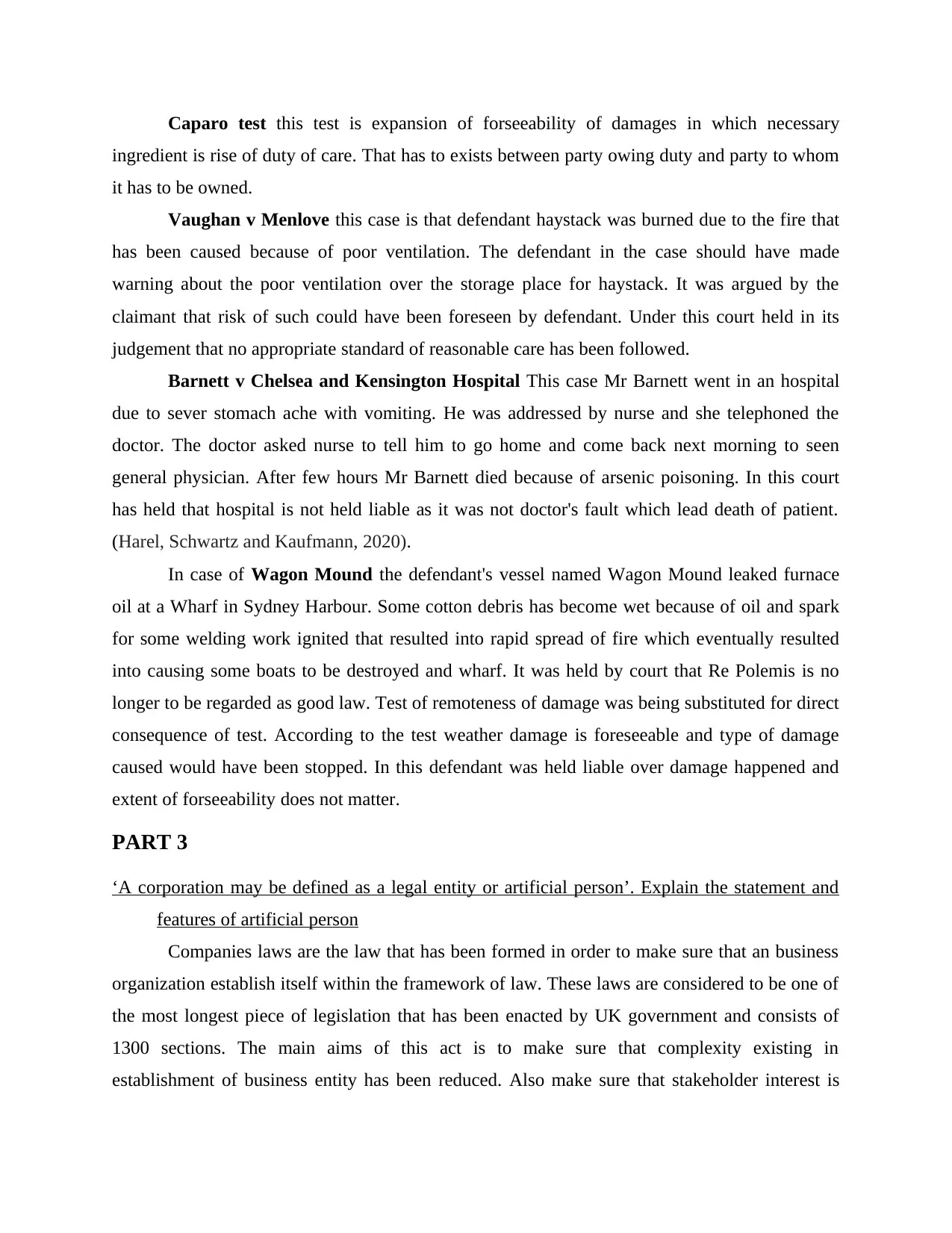
Caparo test this test is expansion of forseeability of damages in which necessary
ingredient is rise of duty of care. That has to exists between party owing duty and party to whom
it has to be owned.
Vaughan v Menlove this case is that defendant haystack was burned due to the fire that
has been caused because of poor ventilation. The defendant in the case should have made
warning about the poor ventilation over the storage place for haystack. It was argued by the
claimant that risk of such could have been foreseen by defendant. Under this court held in its
judgement that no appropriate standard of reasonable care has been followed.
Barnett v Chelsea and Kensington Hospital This case Mr Barnett went in an hospital
due to sever stomach ache with vomiting. He was addressed by nurse and she telephoned the
doctor. The doctor asked nurse to tell him to go home and come back next morning to seen
general physician. After few hours Mr Barnett died because of arsenic poisoning. In this court
has held that hospital is not held liable as it was not doctor's fault which lead death of patient.
(Harel, Schwartz and Kaufmann, 2020).
In case of Wagon Mound the defendant's vessel named Wagon Mound leaked furnace
oil at a Wharf in Sydney Harbour. Some cotton debris has become wet because of oil and spark
for some welding work ignited that resulted into rapid spread of fire which eventually resulted
into causing some boats to be destroyed and wharf. It was held by court that Re Polemis is no
longer to be regarded as good law. Test of remoteness of damage was being substituted for direct
consequence of test. According to the test weather damage is foreseeable and type of damage
caused would have been stopped. In this defendant was held liable over damage happened and
extent of forseeability does not matter.
PART 3
‘A corporation may be defined as a legal entity or artificial person’. Explain the statement and
features of artificial person
Companies laws are the law that has been formed in order to make sure that an business
organization establish itself within the framework of law. These laws are considered to be one of
the most longest piece of legislation that has been enacted by UK government and consists of
1300 sections. The main aims of this act is to make sure that complexity existing in
establishment of business entity has been reduced. Also make sure that stakeholder interest is
ingredient is rise of duty of care. That has to exists between party owing duty and party to whom
it has to be owned.
Vaughan v Menlove this case is that defendant haystack was burned due to the fire that
has been caused because of poor ventilation. The defendant in the case should have made
warning about the poor ventilation over the storage place for haystack. It was argued by the
claimant that risk of such could have been foreseen by defendant. Under this court held in its
judgement that no appropriate standard of reasonable care has been followed.
Barnett v Chelsea and Kensington Hospital This case Mr Barnett went in an hospital
due to sever stomach ache with vomiting. He was addressed by nurse and she telephoned the
doctor. The doctor asked nurse to tell him to go home and come back next morning to seen
general physician. After few hours Mr Barnett died because of arsenic poisoning. In this court
has held that hospital is not held liable as it was not doctor's fault which lead death of patient.
(Harel, Schwartz and Kaufmann, 2020).
In case of Wagon Mound the defendant's vessel named Wagon Mound leaked furnace
oil at a Wharf in Sydney Harbour. Some cotton debris has become wet because of oil and spark
for some welding work ignited that resulted into rapid spread of fire which eventually resulted
into causing some boats to be destroyed and wharf. It was held by court that Re Polemis is no
longer to be regarded as good law. Test of remoteness of damage was being substituted for direct
consequence of test. According to the test weather damage is foreseeable and type of damage
caused would have been stopped. In this defendant was held liable over damage happened and
extent of forseeability does not matter.
PART 3
‘A corporation may be defined as a legal entity or artificial person’. Explain the statement and
features of artificial person
Companies laws are the law that has been formed in order to make sure that an business
organization establish itself within the framework of law. These laws are considered to be one of
the most longest piece of legislation that has been enacted by UK government and consists of
1300 sections. The main aims of this act is to make sure that complexity existing in
establishment of business entity has been reduced. Also make sure that stakeholder interest is
Paraphrase This Document
Need a fresh take? Get an instant paraphrase of this document with our AI Paraphraser
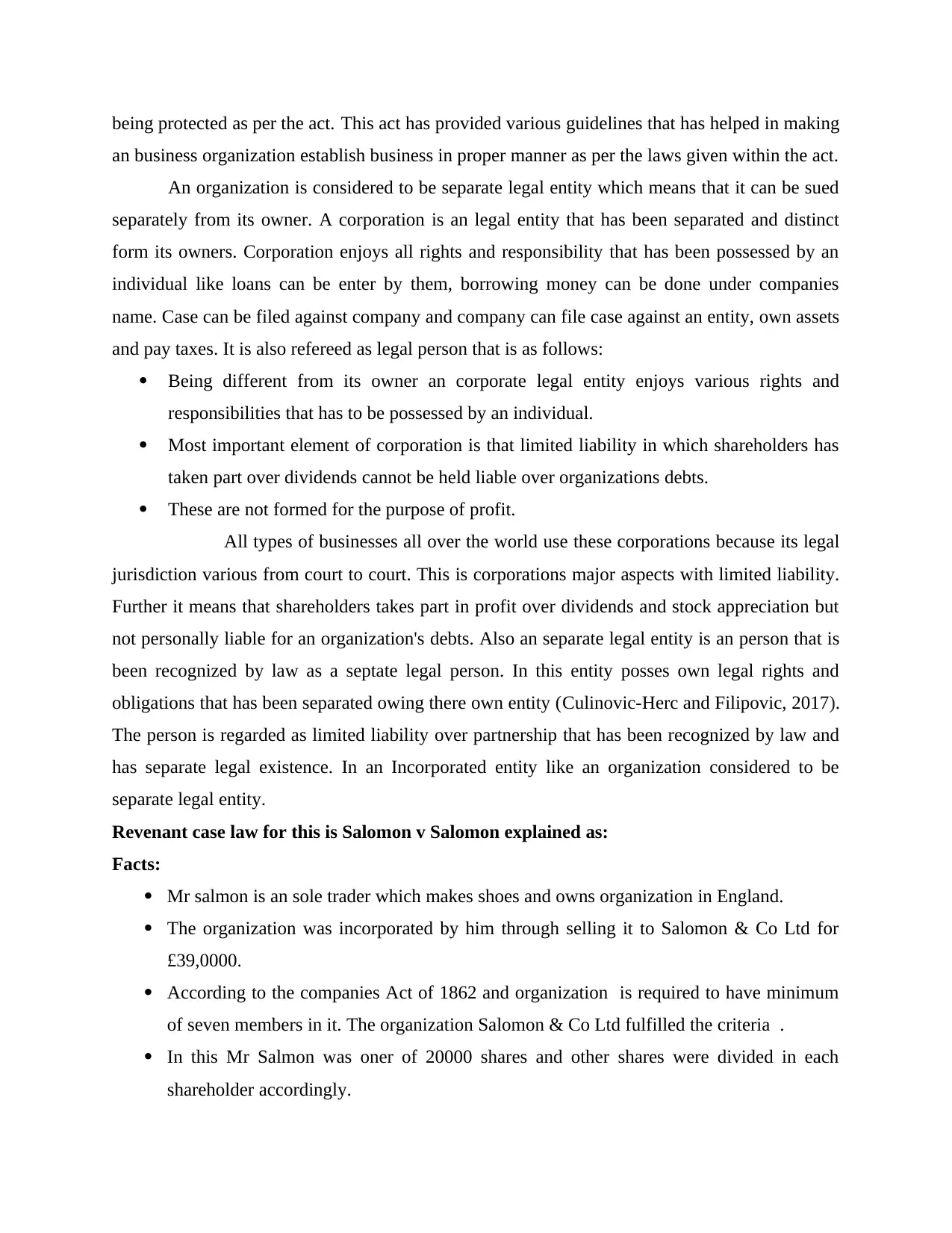
being protected as per the act. This act has provided various guidelines that has helped in making
an business organization establish business in proper manner as per the laws given within the act.
An organization is considered to be separate legal entity which means that it can be sued
separately from its owner. A corporation is an legal entity that has been separated and distinct
form its owners. Corporation enjoys all rights and responsibility that has been possessed by an
individual like loans can be enter by them, borrowing money can be done under companies
name. Case can be filed against company and company can file case against an entity, own assets
and pay taxes. It is also refereed as legal person that is as follows:
Being different from its owner an corporate legal entity enjoys various rights and
responsibilities that has to be possessed by an individual.
Most important element of corporation is that limited liability in which shareholders has
taken part over dividends cannot be held liable over organizations debts.
These are not formed for the purpose of profit.
All types of businesses all over the world use these corporations because its legal
jurisdiction various from court to court. This is corporations major aspects with limited liability.
Further it means that shareholders takes part in profit over dividends and stock appreciation but
not personally liable for an organization's debts. Also an separate legal entity is an person that is
been recognized by law as a septate legal person. In this entity posses own legal rights and
obligations that has been separated owing there own entity (Culinovic-Herc and Filipovic, 2017).
The person is regarded as limited liability over partnership that has been recognized by law and
has separate legal existence. In an Incorporated entity like an organization considered to be
separate legal entity.
Revenant case law for this is Salomon v Salomon explained as:
Facts:
Mr salmon is an sole trader which makes shoes and owns organization in England.
The organization was incorporated by him through selling it to Salomon & Co Ltd for
£39,0000.
According to the companies Act of 1862 and organization is required to have minimum
of seven members in it. The organization Salomon & Co Ltd fulfilled the criteria .
In this Mr Salmon was oner of 20000 shares and other shares were divided in each
shareholder accordingly.
an business organization establish business in proper manner as per the laws given within the act.
An organization is considered to be separate legal entity which means that it can be sued
separately from its owner. A corporation is an legal entity that has been separated and distinct
form its owners. Corporation enjoys all rights and responsibility that has been possessed by an
individual like loans can be enter by them, borrowing money can be done under companies
name. Case can be filed against company and company can file case against an entity, own assets
and pay taxes. It is also refereed as legal person that is as follows:
Being different from its owner an corporate legal entity enjoys various rights and
responsibilities that has to be possessed by an individual.
Most important element of corporation is that limited liability in which shareholders has
taken part over dividends cannot be held liable over organizations debts.
These are not formed for the purpose of profit.
All types of businesses all over the world use these corporations because its legal
jurisdiction various from court to court. This is corporations major aspects with limited liability.
Further it means that shareholders takes part in profit over dividends and stock appreciation but
not personally liable for an organization's debts. Also an separate legal entity is an person that is
been recognized by law as a septate legal person. In this entity posses own legal rights and
obligations that has been separated owing there own entity (Culinovic-Herc and Filipovic, 2017).
The person is regarded as limited liability over partnership that has been recognized by law and
has separate legal existence. In an Incorporated entity like an organization considered to be
separate legal entity.
Revenant case law for this is Salomon v Salomon explained as:
Facts:
Mr salmon is an sole trader which makes shoes and owns organization in England.
The organization was incorporated by him through selling it to Salomon & Co Ltd for
£39,0000.
According to the companies Act of 1862 and organization is required to have minimum
of seven members in it. The organization Salomon & Co Ltd fulfilled the criteria .
In this Mr Salmon was oner of 20000 shares and other shares were divided in each
shareholder accordingly.
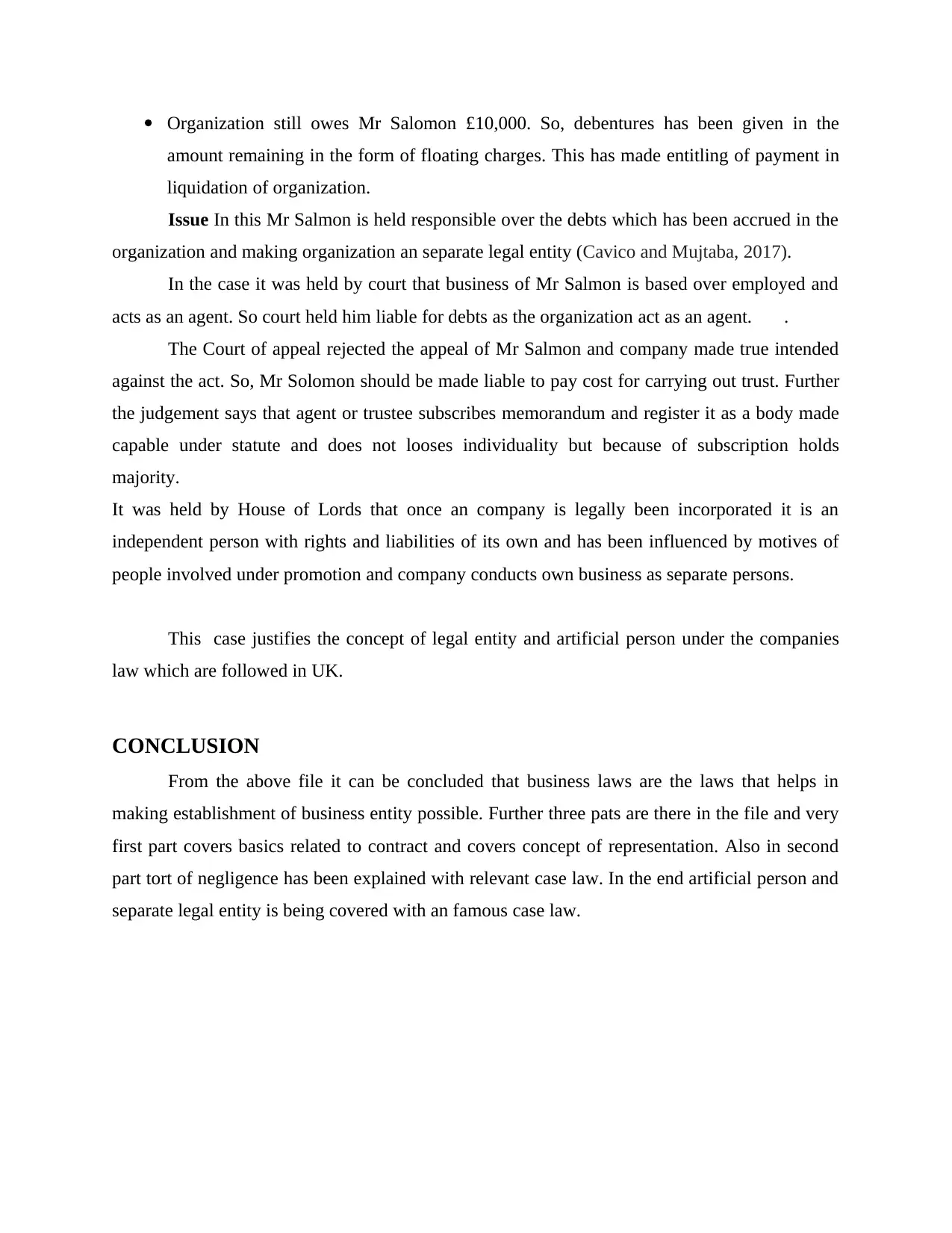
Organization still owes Mr Salomon £10,000. So, debentures has been given in the
amount remaining in the form of floating charges. This has made entitling of payment in
liquidation of organization.
Issue In this Mr Salmon is held responsible over the debts which has been accrued in the
organization and making organization an separate legal entity (Cavico and Mujtaba, 2017).
In the case it was held by court that business of Mr Salmon is based over employed and
acts as an agent. So court held him liable for debts as the organization act as an agent. .
The Court of appeal rejected the appeal of Mr Salmon and company made true intended
against the act. So, Mr Solomon should be made liable to pay cost for carrying out trust. Further
the judgement says that agent or trustee subscribes memorandum and register it as a body made
capable under statute and does not looses individuality but because of subscription holds
majority.
It was held by House of Lords that once an company is legally been incorporated it is an
independent person with rights and liabilities of its own and has been influenced by motives of
people involved under promotion and company conducts own business as separate persons.
This case justifies the concept of legal entity and artificial person under the companies
law which are followed in UK.
CONCLUSION
From the above file it can be concluded that business laws are the laws that helps in
making establishment of business entity possible. Further three pats are there in the file and very
first part covers basics related to contract and covers concept of representation. Also in second
part tort of negligence has been explained with relevant case law. In the end artificial person and
separate legal entity is being covered with an famous case law.
amount remaining in the form of floating charges. This has made entitling of payment in
liquidation of organization.
Issue In this Mr Salmon is held responsible over the debts which has been accrued in the
organization and making organization an separate legal entity (Cavico and Mujtaba, 2017).
In the case it was held by court that business of Mr Salmon is based over employed and
acts as an agent. So court held him liable for debts as the organization act as an agent. .
The Court of appeal rejected the appeal of Mr Salmon and company made true intended
against the act. So, Mr Solomon should be made liable to pay cost for carrying out trust. Further
the judgement says that agent or trustee subscribes memorandum and register it as a body made
capable under statute and does not looses individuality but because of subscription holds
majority.
It was held by House of Lords that once an company is legally been incorporated it is an
independent person with rights and liabilities of its own and has been influenced by motives of
people involved under promotion and company conducts own business as separate persons.
This case justifies the concept of legal entity and artificial person under the companies
law which are followed in UK.
CONCLUSION
From the above file it can be concluded that business laws are the laws that helps in
making establishment of business entity possible. Further three pats are there in the file and very
first part covers basics related to contract and covers concept of representation. Also in second
part tort of negligence has been explained with relevant case law. In the end artificial person and
separate legal entity is being covered with an famous case law.
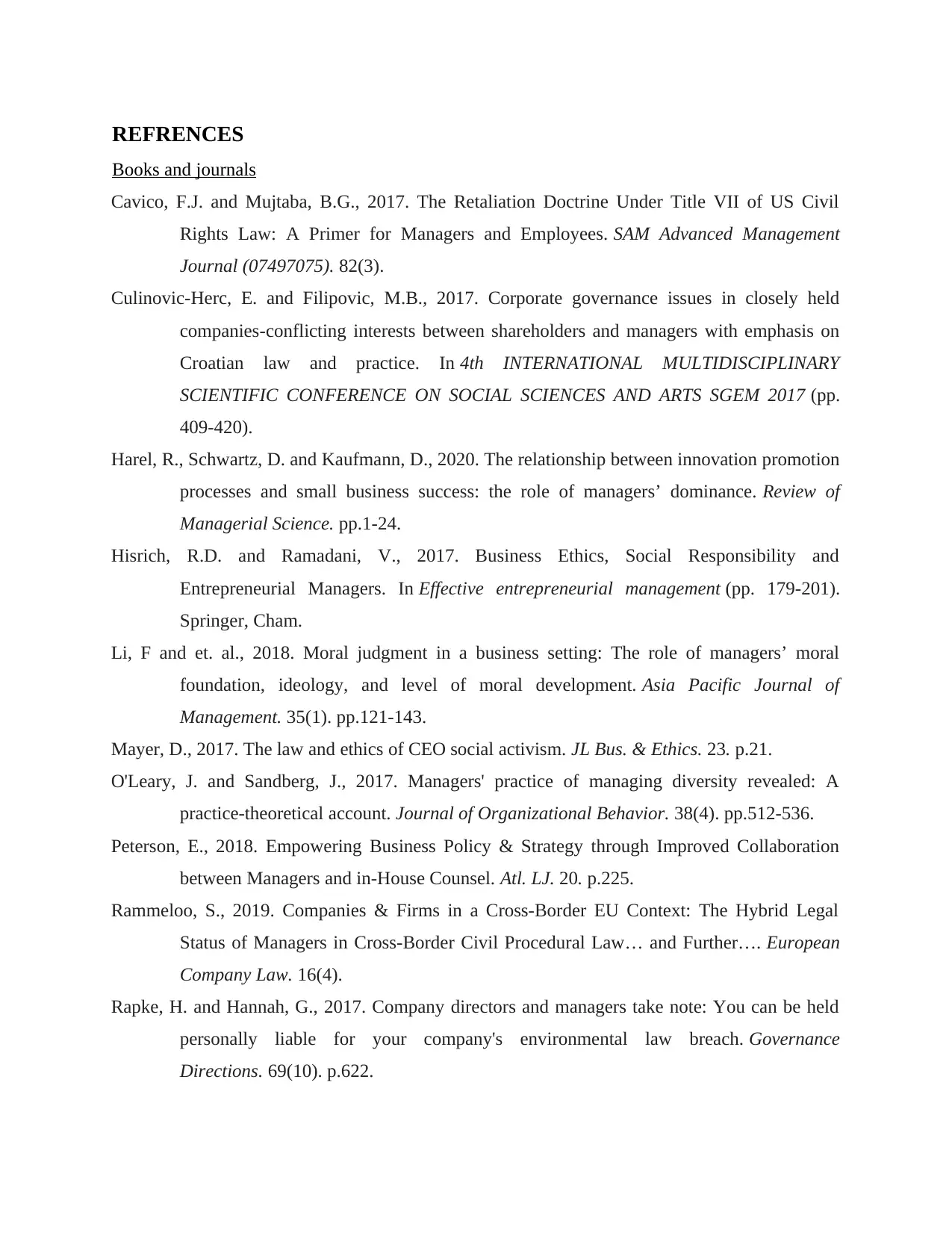
REFRENCES
Books and journals
Cavico, F.J. and Mujtaba, B.G., 2017. The Retaliation Doctrine Under Title VII of US Civil
Rights Law: A Primer for Managers and Employees. SAM Advanced Management
Journal (07497075). 82(3).
Culinovic-Herc, E. and Filipovic, M.B., 2017. Corporate governance issues in closely held
companies-conflicting interests between shareholders and managers with emphasis on
Croatian law and practice. In 4th INTERNATIONAL MULTIDISCIPLINARY
SCIENTIFIC CONFERENCE ON SOCIAL SCIENCES AND ARTS SGEM 2017 (pp.
409-420).
Harel, R., Schwartz, D. and Kaufmann, D., 2020. The relationship between innovation promotion
processes and small business success: the role of managers’ dominance. Review of
Managerial Science. pp.1-24.
Hisrich, R.D. and Ramadani, V., 2017. Business Ethics, Social Responsibility and
Entrepreneurial Managers. In Effective entrepreneurial management (pp. 179-201).
Springer, Cham.
Li, F and et. al., 2018. Moral judgment in a business setting: The role of managers’ moral
foundation, ideology, and level of moral development. Asia Pacific Journal of
Management. 35(1). pp.121-143.
Mayer, D., 2017. The law and ethics of CEO social activism. JL Bus. & Ethics. 23. p.21.
O'Leary, J. and Sandberg, J., 2017. Managers' practice of managing diversity revealed: A
practice‐theoretical account. Journal of Organizational Behavior. 38(4). pp.512-536.
Peterson, E., 2018. Empowering Business Policy & Strategy through Improved Collaboration
between Managers and in-House Counsel. Atl. LJ. 20. p.225.
Rammeloo, S., 2019. Companies & Firms in a Cross-Border EU Context: The Hybrid Legal
Status of Managers in Cross-Border Civil Procedural Law… and Further…. European
Company Law. 16(4).
Rapke, H. and Hannah, G., 2017. Company directors and managers take note: You can be held
personally liable for your company's environmental law breach. Governance
Directions. 69(10). p.622.
Books and journals
Cavico, F.J. and Mujtaba, B.G., 2017. The Retaliation Doctrine Under Title VII of US Civil
Rights Law: A Primer for Managers and Employees. SAM Advanced Management
Journal (07497075). 82(3).
Culinovic-Herc, E. and Filipovic, M.B., 2017. Corporate governance issues in closely held
companies-conflicting interests between shareholders and managers with emphasis on
Croatian law and practice. In 4th INTERNATIONAL MULTIDISCIPLINARY
SCIENTIFIC CONFERENCE ON SOCIAL SCIENCES AND ARTS SGEM 2017 (pp.
409-420).
Harel, R., Schwartz, D. and Kaufmann, D., 2020. The relationship between innovation promotion
processes and small business success: the role of managers’ dominance. Review of
Managerial Science. pp.1-24.
Hisrich, R.D. and Ramadani, V., 2017. Business Ethics, Social Responsibility and
Entrepreneurial Managers. In Effective entrepreneurial management (pp. 179-201).
Springer, Cham.
Li, F and et. al., 2018. Moral judgment in a business setting: The role of managers’ moral
foundation, ideology, and level of moral development. Asia Pacific Journal of
Management. 35(1). pp.121-143.
Mayer, D., 2017. The law and ethics of CEO social activism. JL Bus. & Ethics. 23. p.21.
O'Leary, J. and Sandberg, J., 2017. Managers' practice of managing diversity revealed: A
practice‐theoretical account. Journal of Organizational Behavior. 38(4). pp.512-536.
Peterson, E., 2018. Empowering Business Policy & Strategy through Improved Collaboration
between Managers and in-House Counsel. Atl. LJ. 20. p.225.
Rammeloo, S., 2019. Companies & Firms in a Cross-Border EU Context: The Hybrid Legal
Status of Managers in Cross-Border Civil Procedural Law… and Further…. European
Company Law. 16(4).
Rapke, H. and Hannah, G., 2017. Company directors and managers take note: You can be held
personally liable for your company's environmental law breach. Governance
Directions. 69(10). p.622.
Secure Best Marks with AI Grader
Need help grading? Try our AI Grader for instant feedback on your assignments.
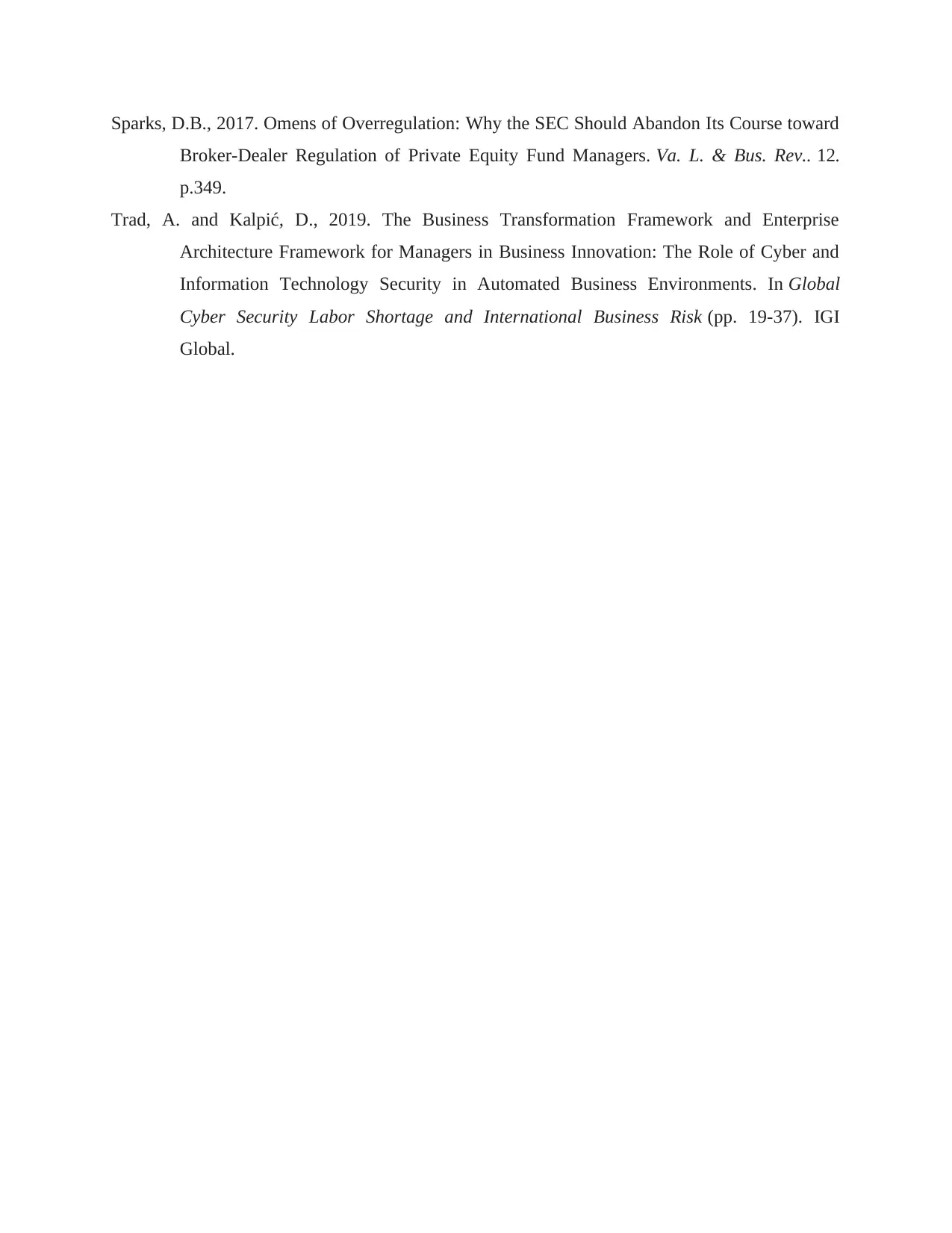
Sparks, D.B., 2017. Omens of Overregulation: Why the SEC Should Abandon Its Course toward
Broker-Dealer Regulation of Private Equity Fund Managers. Va. L. & Bus. Rev.. 12.
p.349.
Trad, A. and Kalpić, D., 2019. The Business Transformation Framework and Enterprise
Architecture Framework for Managers in Business Innovation: The Role of Cyber and
Information Technology Security in Automated Business Environments. In Global
Cyber Security Labor Shortage and International Business Risk (pp. 19-37). IGI
Global.
Broker-Dealer Regulation of Private Equity Fund Managers. Va. L. & Bus. Rev.. 12.
p.349.
Trad, A. and Kalpić, D., 2019. The Business Transformation Framework and Enterprise
Architecture Framework for Managers in Business Innovation: The Role of Cyber and
Information Technology Security in Automated Business Environments. In Global
Cyber Security Labor Shortage and International Business Risk (pp. 19-37). IGI
Global.

1 out of 12
Related Documents
Your All-in-One AI-Powered Toolkit for Academic Success.
+13062052269
info@desklib.com
Available 24*7 on WhatsApp / Email
![[object Object]](/_next/static/media/star-bottom.7253800d.svg)
Unlock your academic potential
© 2024 | Zucol Services PVT LTD | All rights reserved.





